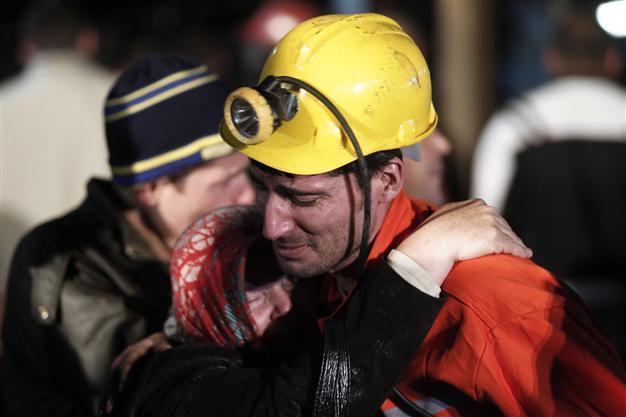Turkey long a graveyard for miners
ISTANBUL – Anadolu Agency

A miner hugs a relative in front of a coal mine site in Soma, a district in Turkey's western province of Manisa May 14, 2014. REUTERS Photo
The catastrophic death of well over 200 workers in an Aegean coal mine has put Turkey’s abysmally poor mining accident record once again under scrutiny, while prompting mounting uproar against the repercussions of the state’s diminishing presence in the sector.
More than 3,000 people have been killed in mining accidents across Turkey since 1941, mostly due to fires, landslide or explosions.
A report from 2010 stated that the number of deaths in mine accidents in Turkey outnumbers those in the world’s biggest coal producers, the Unites States and China, in terms of fatalities per ton.
Figures show the country is much more dangerous than any country for a miner, even than China, which has the largest number of coal-mining fatalities in any country.
Although the number of miners killed in accidents is far higher in China, the number of deaths per ton of coal production in China was seven times lower than Turkey in 2008, according to a mining sector overview report published by the Economy Policy Research Foundation of Turkey (TEPAV) in 2010.
“While the number of deaths per million ton of coal production is 7.22 in Turkey, it stood at 1.27 in China and 0.02 in the United States in the same year,” the report said, citing official data obtained from the country’s related agencies.
The numbers also reveal the number of deaths per 100 million tons of coal production for the 2000-2008 period, which ranges between one and six in the U.S. and between 250 and 900 in Turkey.
Accidents in mining and quarrying sectorsThe rate of industrial accidents is highest in the mining and quarrying sectors in the country, according to the Turkish Statistics Institute (TÜİK). Some 10.4 percent of industrial accidents occurred in the mining and quarrying sectors last year, the body said.
Until today, the deadliest accident in Turkish mining history occurred in a facility in the Black Sea province of Zonguldak’s Kozlu district in 1992 due to a pit gas explosion that left 263 people dead.
Over 100,000 people have also been wounded in accidents, according to figures.
“Improper air conditioning systems, lack of escape routes, insufficient personal safety precautions, inefficient infrastructure and low technology pave the way to death for miners,” the TEPAV report said.
“All these predictable and preventable factors force Turkey to commit to work on a sustainable road map for the lives of its miners.”
The increasing number of deaths through occupational accidents at mines is triggering criticism of the state’s gradual retreat from the mining sector under Justice and Development Party (AKP) rule.
Model developed by ministry In 2005, the Energy Ministry developed a model of obtaining royalties from electric production instead of charging for coal, as it had previously done for 30 years through the state-run Turkish Coal Enterprises (TKİ).
The Turkish Coal Institute (TKK) then opened tenders for the coal mines to transfer their operational rights to private companies, which led the state to become only a buyer of the product.
According to the new model, the company sells its production to the TKİ to be put into the market for industrial and heating purposes.
The critics of the state’s labor policies say its exit from the sector and the easing of controls over workplace conditions at mines has stirred a rise in the employment of subcontractors and increasing negligence over safety measures.
Tayfun Görgün, chairman of mining Union Dev-Maden-Sen, said accidents were less frequent before 2005.
“These are not accidents, they are murders. And from union to auditor, from minister to prime minister, [everyone] takes part in the crime,” he said.
“Accidents exploded when these fields were given to the private sector because the subcontractor labor model has become a state policy as its way has been paved,” Görgün said, noting that this had resulted in less public oversight of the sector.
“People have begun to be employed illegally or with too-low incomes; work safety has been neglected. Auditors looked over the deficiencies. Security measures have been put on the back burner to reduce costs,” he said.
The TEPAV report also said mines run by private companies or subcontractors pose more of a danger than mines run by the state through the TTK. Since 2008, the number of deaths in mines run by private companies has been twice that of those in state mines with regard to production figures.
Disaster in SomaOn May 13, at least 238 coal miners were killed and hundreds were trapped at a mine in the western province of Manisa’s Soma district after a fire broke out following an explosion in a power distribution unit.
In a statement released early May 14, Energy Minister Taner Yıldız also expressed concerns that the death toll could rise as over 300 workers could still be trapped inside, according to reports.
Some major mining accidents in Turkey:
March 7, 1983: Methane blast in Armutçuk killed 103
April 10, 1983: Methane blast in Kozlu killed 10
Jan. 31, 1987: Cave in in Kozlu killed eight
Jan. 31, 1990: Methane blast in Amasra killed five
Feb. 7, 1990: Methane blast in Amasya killed 68
March 3, 1992, Methane blast in Kozlu killed 263
March 26, 1995: Methane blast in Sorgun killed 37
Nov. 22, 2003: Methane blast in Ermenek killed 10
Sept. 8, 2004: Fire in a mine in Küre killed 19
June 2, 2006: Methane blast in Dursunbey killed 17
Dec. 10, 2009: Methane blast in Mustafakemalpaşa killed 19
May 17, 2010: Methane blast in Zonguldak killed 30
Jan. 8, 2013: Methane blast in Kozlu killed eight
